Investigation of Liquid–Liquid Reaction Phenomena of Aluminum in Calcium Silicate Slag
Abstract
1. Introduction
2. Materials and Methods
2.1. Experimental
2.2. Part I: Qualitative and Quantitative Analysis Using EPMA
2.2.1. Method Determining the Average Composition of the Si Alloy Droplets in the Slag
2.2.2. Analysis of Si Alloy Droplets in EPMA
2.3. Part II: Melting Behavior of Wetting Droplet
2.4. Part III: Number and Radius of Si Alloy Droplets
2.5. Thermodynamic and Physical Property Calculations
3. Results
3.1. Part I
3.1.1. Accumulation of Product Slag–Barrier at the Al Alloy–Slag Interface
3.1.2. Conversion
3.1.3. Al Alloy Composition
3.1.4. Composition of Product Slag and Si Alloy Droplets
3.2. Part II
In Situ Analysis of Al Metal and Slag Melting
3.3. Part III
4. Discussion
4.1. Dissolution Mechanism
4.2. Shrinking Behavior of Wetting Droplet
4.3. Proposed Phenomena Involved
4.3.1. Electrocapillary Effect
4.3.2. Hydrodynamic Phenomena
5. Conclusions
- Although no external convection was present, chemical reaction occurs instantaneously between Al and CaO-SiO2 at 1550–1650 °C. The estimated mass of emulsified Si alloy droplets and oxygen flux across the interface were highest during the first 3 min of the holding time, seemingly less significant at 1550 °C and somewhat higher at 1650 °C than at 1600 °C. The rate decreases significantly during the subsequent 3–20 min at all temperatures, statistically attributed to increased kinematic viscosity or decreased electrical conductivity at 1550 °C, and to increased surface tension at 1600 °C. A statistically significant relationship was observed at 1650 °C, similar to that observed at 1550 °C.
- On the surface of the Al alloy, a thin solid layer comprised of CaAl12O19 and CaAl4O7, measuring a few microns in thickness, was observed. Particularly notable was the presence of CaAl4O7, consistent across various temperatures and durations. This solid layer likely impeded the reaction at 1550 °C due to its slow dissolution, attributed to the partially liquid slag and comparatively higher viscosity compared to higher holding temperatures. At 1600–1650 °C, the complete dissolution of solids was observed between 3 and 20 min of the holding time.
- Novel characteristics found for this metal–slag system at higher temperatures of 1600–1650 °C compared to 1550 °C can be summarized as (i) a thinner calcium aluminate product layer, (ii) a higher conversion degree and conversion rate, (iii) more change in Al alloy and slag composition, (iv) faster shrinkage of the wetting droplet, and (v) the number per mass of Si alloy droplets was significantly less regardless of holding time. Trials at 1600 and 1650 °C appeared more similar in terms of overall reaction behavior, although deviation tended to increase above 3 min holding time due to more favorable liquid properties of the slag phase.
- Estimated oxygen flux (gm−2s−1) across the Al alloy–slag interface was well above the critical value (0.1) determined by previous work to obtain interfacial depression and emulsion. The flux was calculated to average 10.3–15.4 gm−2s−1 within 3 min of the holding time, followed by 3.6 gm−2s−1 between 3–20 min and 0.1 between 20–40 min at 1650 °C, correspondingly 0.7 and 1.7 for 1600 °C and 1.0 and 1.6 for 1550 °C.
- The electrocapillary effect and hydrodynamic phenomena represent potential occurrences during the reaction process. Apparent interfacial tension depression and Si alloy emulsion result from the accumulation of interfacial charge due to varying mass transfer coefficients of reactants and products, thereby inducing hydrodynamic phenomena that further facilitate the reaction. At 1550 °C, the presence of an interfacial product layer blocks weaker eddy currents, thereby impeding the reaction rate.
- This study underscores the significance of transient or product slag properties as the paramount parameter for controlling kinetics and facilitating metal–slag separation.
Author Contributions
Funding
Data Availability Statement
Acknowledgments
Conflicts of Interest
References
- Innovative Pilot for Silicon Production with Low Environmental Impact Using Secondary Aluminium and Silicon Raw Materials. 2020. Available online: https://cordis.europa.eu/project/id/869268 (accessed on 27 November 2023).
- Tranell, G.; Safarian, J.; Wallin, M. SisAl—A New Process for Production of Silicon. In Silicon for the Chemical and Solar Industry XV; NTNU: Trondheim, Norway, 2020; pp. 129–139. ISBN 978-82-997357-9-7. [Google Scholar]
- Prabriputaloong, K.; Piggott, M. Reduction of SiO2 by molten Al. J. Am. Ceram. Soc. 1973, 56, 184–185. [Google Scholar] [CrossRef]
- Yoshikawa, N.; Hattori, A.; Taniguchi, S. Growth rate of reaction layer between SiO2 and molten Al above 1473 K. Mater. Trans. 2005, 46, 842–845. [Google Scholar] [CrossRef]
- Gaye, H.; Lucas, L.D.; Olette, M.; Riboud, P.V. Metal-slag interfacial properties: Equilibrium values and “dynamic” phenomena. Can. Metall. Q. 1984, 23, 179–191. [Google Scholar] [CrossRef]
- Hagemann, R.; Heller, H.P.; Lachmann, S.; Seetharaman, S.; Scheller, P.R. Slag entrainment in continuous casting and effect of interfacial tension. Ironmak. Steelmak. 2012, 39, 508–513. [Google Scholar] [CrossRef]
- Zhu, M.; Philipson, H.; BlandholL, K.; Djupvik, V.; Engvoll, K.; Safarian, J.; Tang, K.; Wallin, M.; Tranell, G. Pilot Scale Aluminothermic Production of Silicon Alloy and Alumina-rich Slag. ACS Sustain. Chem. Eng. 2023. submitted and under final peer review. [Google Scholar]
- Philipson, H.; Blandhol, K.; Engvoll, K.; Djupvik, V.; Wallin, M.; Tranell, G.; Haarberg, T. Preliminary Techno-Economic Considerations of the Sisal Process—Closing Materials Loops through Industrial Symbiosis. In Proceedings of the Silicon for the Chemical & Solar Industry XVI, Trondheim, Norway, 14–16 June 2022; NTNU: Trondheim, Norway, 2022. [Google Scholar]
- Philipson, H.; Wallin, M.; Einarsrud, K.E.; Tranell, G. Kinetics of silicon production by aluminothermic reduction of silica using aluminum and aluminum dross as reductants. In Proceedings of the 16th International Ferro-Alloys Congress (INFACON XVI), Virtual, 27–29 September 2021; NTNU: Trondheim, Norway, 2021. [Google Scholar]
- Sørli, F. Refining Kinetics of the SisAl Silicon Alloy. Master’s Thesis, Norwegian University of Science and Technology (NTNU), Department of Materials Science and Engineering, Trondheim, Norway, 2023. [Google Scholar]
- Zhu, M.; Arntsen, A.S.; Safarian, J. Silicon Recovery Via the Acid Leaching of a Si-Ca-Al Alloy Produced by the SisAl Process. In Proceedings of the Silicon for the Chemical & Solar Industry XVI, Trondheim, Norway, 14–16 June 2022; NTNU: Trondheim, Norway, 2022. [Google Scholar]
- Georgala, E.; Vafeias, M.; Bempelou, A.; Balomenos, E.; Panias, D. Aluminium extraction from a calcium aluminate slag using sodium carbonate based on the critical examination of the patented industrial Pedersen process. Hydrometallurgy 2023, 222, 106188. [Google Scholar] [CrossRef]
- Marinos, D.; Kotsanis, D.; Alexandri, A.; Balomenos, E.; Panias, D. Carbonation of Sodium Aluminate/Sodium Carbonate Solutions for Precipitation of Alumina Hydrates—Avoiding Dawsonite Formation. Crystals 2021, 11, 836. [Google Scholar] [CrossRef]
- Mwase, J.M.; Vafeias, M.; Marinos, D.; Dimitrios, P.; Safarian, J. Investigating Aluminum Tri-Hydroxide Production from Sodium Aluminate Solutions in the Pedersen Process. Processes 2022, 10, 1370. [Google Scholar] [CrossRef]
- Mwase, J.; Safarian, J. Investigating the Leaching, Desilication and Precipitation of Aluminium Tri-Hydroxides From a Bauxite Residue-Bauxite By-Product Slag. In Proceedings of the 38th ICSOBA Conference, Virtual, 16–18 November 2020. [Google Scholar]
- Taşyürek, K.C.; Buğdaycı, M.; Yücel, O. Reduction conditions of metallic calcium from magnesium production residues. Metals 2018, 8, 383. [Google Scholar] [CrossRef]
- Jacob, K.; Srikanth, S. Physical chemistry of the reduction of calcium oxide with aluminum in vacuum. High Temp. Mater. Process. 1990, 9, 77–92. [Google Scholar] [CrossRef]
- Kudyba, A.; Akhtar, S.; Johansen, I.; Safarian, J. Aluminothermic reduction of manganese oxide from selected MnO-containing slags. Materials 2021, 14, 356. [Google Scholar] [CrossRef] [PubMed]
- Philipson, H.; Solbakk, G.L.; Wallin, M.; Einarsrud, K.E.; Tranell, G. Innovative Utilization of Aluminum-Based Secondary Materials for Production of Metallurgical Silicon and Alumina-Rich Slag. In Light Metals 2022; Eskin, D., Ed.; The Minerals, Metals & Materials Series; Springer: Cham, Switzerland, 2022; pp. 1038–1045. [Google Scholar]
- Solbakk, G.L. The Effect of Varying CaO/SiO2 Ratios and Reductant Addition in Silicon Production by Aluminothermic Reduction of Silica Based Slags. Master’s Thesis, Norwegian University of Science and Technology (NTNU), Department of Materials Science and Engineering, Trondheim, Norway, 2021. [Google Scholar]
- Kozakevitch, P.; Urbain, G.; Sage, M. Sur la tension interfaciale fonte/laitier et le mécanisme de désulfuration. Rev. Met. 1955, 52, 161–172. [Google Scholar] [CrossRef]
- Davies, J.T.; Rideal, E.K. Interfacial Phenomena; Academic Press: New York, NY, USA, 1961. [Google Scholar]
- Riboud, P.; Lucas, L. Influence of mass transfer upon surface phenomena in iron and steelmaking. Can. Metall. Q. 1981, 20, 199–208. [Google Scholar] [CrossRef]
- Chung, Y.; Cramb, A.W. Dynamic and equilibrium interfacial phenomena in liquid steel-slag systems. Metall. Mater. Trans. B 2000, 31, 957–971. [Google Scholar] [CrossRef]
- Ooi, H.; Nozaki, T.; Yoshii, H. The effect of chemical reactions on the interfacial tension between iron and CaO-SiO2-Al2O3 slag. Trans. Iron Steel Inst. Jpn. 1974, 14, 9–16. [Google Scholar] [CrossRef]
- Bublik, S.; Tangstad, M.; Einarsrud, K.E. Interfacial Behaviour in Ferroalloys: The Influence of FeMn Slag Composition. Metall. Mater. Trans. B 2022, 53, 3276–3291. [Google Scholar] [CrossRef]
- Gopal, E. Principles of Emulsion Formation; Academic Press: London, UK, 1968; pp. 1–75. [Google Scholar]
- Sharan, A. Interfacial Tensions of Liquid Iron-Nickel and Iron-Chromium Alloys. Ph.D. Thesis, Department of Materials Science and Engineering, Carnegie Mellon University, Pittsburgh, PA, USA, 1993. [Google Scholar]
- Parra, R.; Allibert, M. Metal-slag reaction through a solid interfacial layer. Can. Metall. Q. 1999, 38, 11–21. [Google Scholar] [CrossRef]
- Richardson, F. Interfacial phenomena and metallurgical processes. Can. Metall. Q. 1982, 21, 111–119. [Google Scholar] [CrossRef]
- Richardson, F. Interfacial phenomena in metallurgical reactions. Trans. Iron Steel Inst. Jpn. 1974, 14, 1–8. [Google Scholar] [CrossRef]
- Rhamdhani, M.A.; Coley, K.S.; Brooks, G. Analysis of the source of dynamic interfacial phenomena during reaction between metal droplets and slag. Metall. Mater. Trans. B 2005, 36, 591–604. [Google Scholar] [CrossRef]
- Bainbridge, G.; Sawistowski, H. Surface tension effects in sieve plate distillation columns. Chem. Eng. Sci. 1964, 19, 992–993. [Google Scholar] [CrossRef]
- Dumay, C.; Allibert, M. Distribution of Al and Ca between ferro-silicons and CaO-Al2O3-SiO2 slags at 1450 °C. Scand. J. Metall. 2002, 31, 107–114. [Google Scholar] [CrossRef]
- Choi, J.Y.; Lee, H.G.; Kim, J.S. Dissolution rate of Al2O3 into molten CaO-SiO2-Al2O3 slags. ISIJ Int. 2002, 42, 852–860. [Google Scholar] [CrossRef]
- Miao, K.; Haas, A.; Sharma, M.; Mu, W.; Dogan, N. In situ observation of calcium aluminate inclusions dissolution into steelmaking slag. Metall. Mater. Trans. B 2018, 49, 1612–1623. [Google Scholar] [CrossRef]
- Imagej—Image Processing and Analysis in Java. Available online: https://imagej.net/ij/ (accessed on 2 November 2023).
- Bale, C.W.; Bélisle, E.; Chartrand, P.; Decterov, S.A.; Eriksson, G.; Gheribi, A.E.; Hack, K.; Jung, I.H.; Kang, Y.B.; Melançon, J. Reprint of: FactSage thermochemical software and databases, 2010–2016. Calphad 2016, 55, 1–19. [Google Scholar] [CrossRef]
- Ken Mills—Slag Modelling. 2011. Available online: https://www.pyrometallurgy.co.za/KenMills/ (accessed on 25 November 2023).
- Mills, K. The estimation of slag properties. South. Afr. Pyrometall. 2011, 7, 35–42. [Google Scholar]
- Oishi, Y.; Cooper, A., Jr.; Kingery, W. Dissolution in ceramic systems: III, boundary layer concentration gradients. J. Am. Ceram. Soc. 1965, 48, 88–95. [Google Scholar] [CrossRef]
- Sun, H.; Nakashima, K.; Mori, K. Influence of slag composition on slag–iron interfacial tension. ISIJ Int. 2006, 46, 407–412. [Google Scholar] [CrossRef]
- Rhamdhani, M.; Brooks, G.; Coley, K. Analysis of interfacial area changes during spontaneous emulsification of metal droplets in slag. Metall. Mater. Trans. B 2006, 37, 1087–1091. [Google Scholar] [CrossRef]
- Rhamdhani, M.A.; Coley, K.; Brooks, G. Kinetics of metal/slag reactions during spontaneous emulsification. Metall. Mater. Trans. B 2005, 36, 219–227. [Google Scholar] [CrossRef]
- Zhao, B.; Zhang, J.; Yan, B. Interfacial phenomena and reaction kinetics between high Al molten steel and CaO-SiO2-type flux. Metals 2022, 12, 391. [Google Scholar] [CrossRef]
- Sichen, D.; White, J.F. Does Interfacial Tension Play the Most Important Role in Slag-Metal Reactions? An Important Aspect in Process Optimization. In Advances in Molten Slags, Fluxes, and Salts: Proceedings of the 10th International Conference on Molten Slags, Fluxes and Salts, Seattle, WC, USA, 22–25 May 2016; Springer: Cham, Switzerland; Seattle, WC, USA, 2016. [Google Scholar]

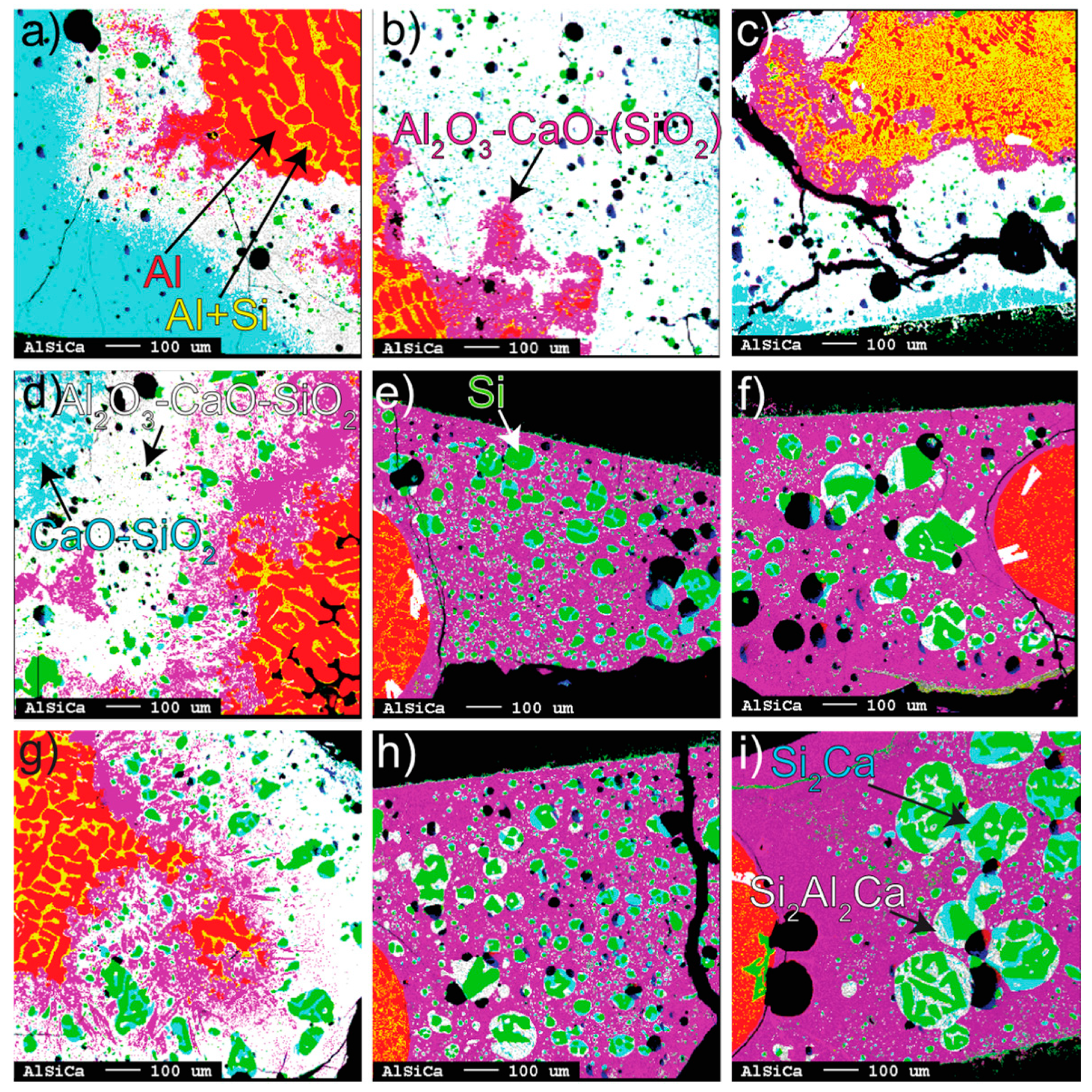
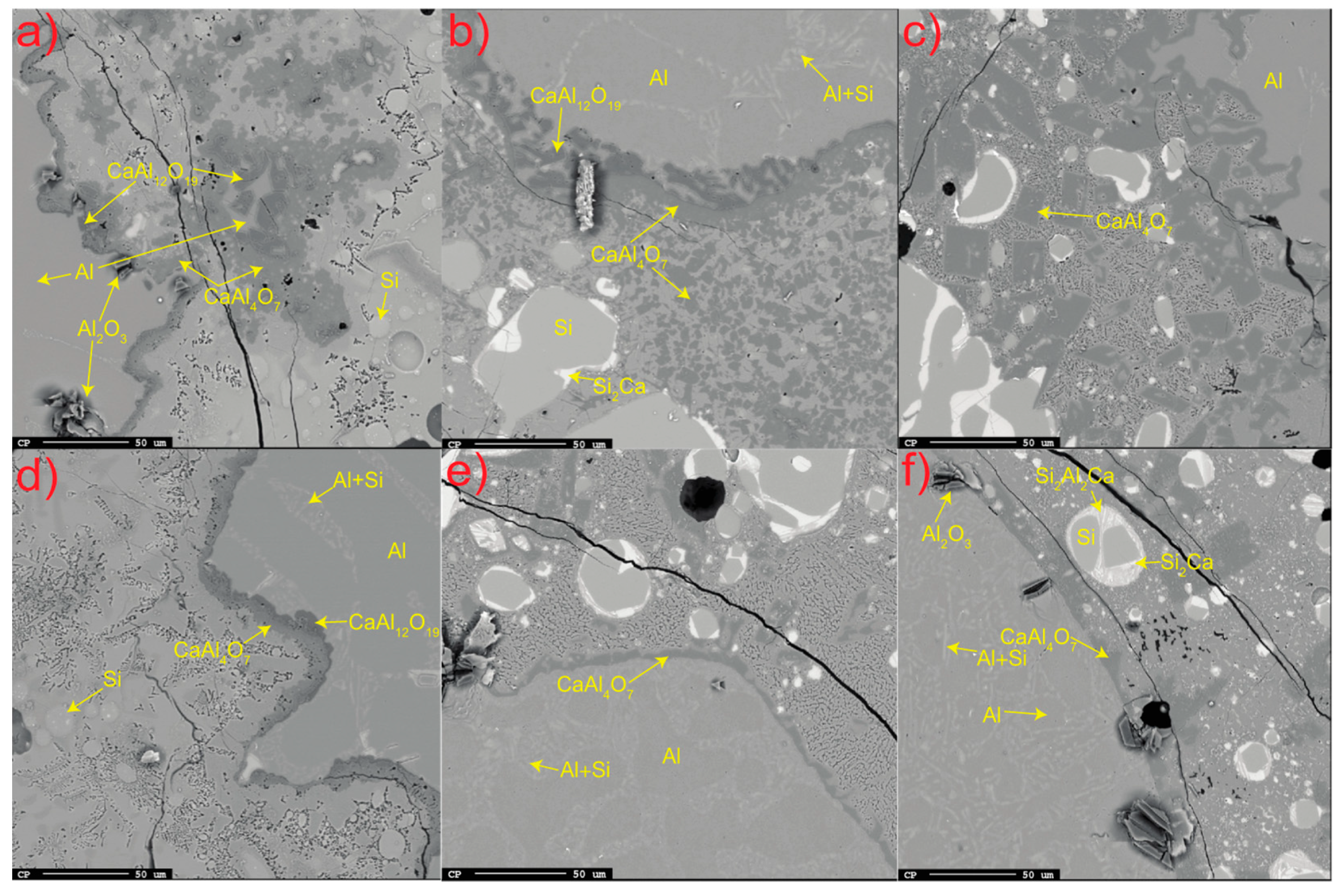
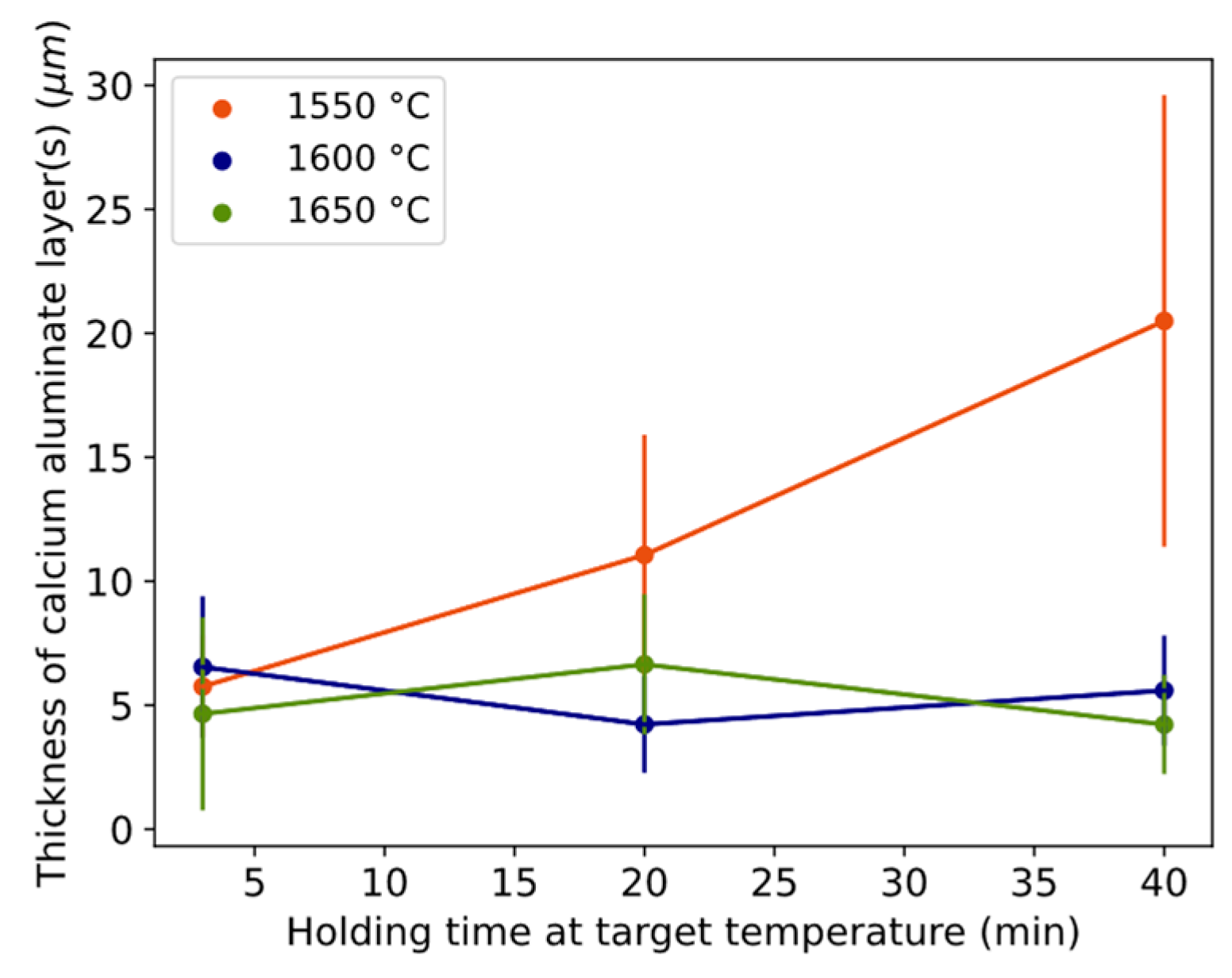
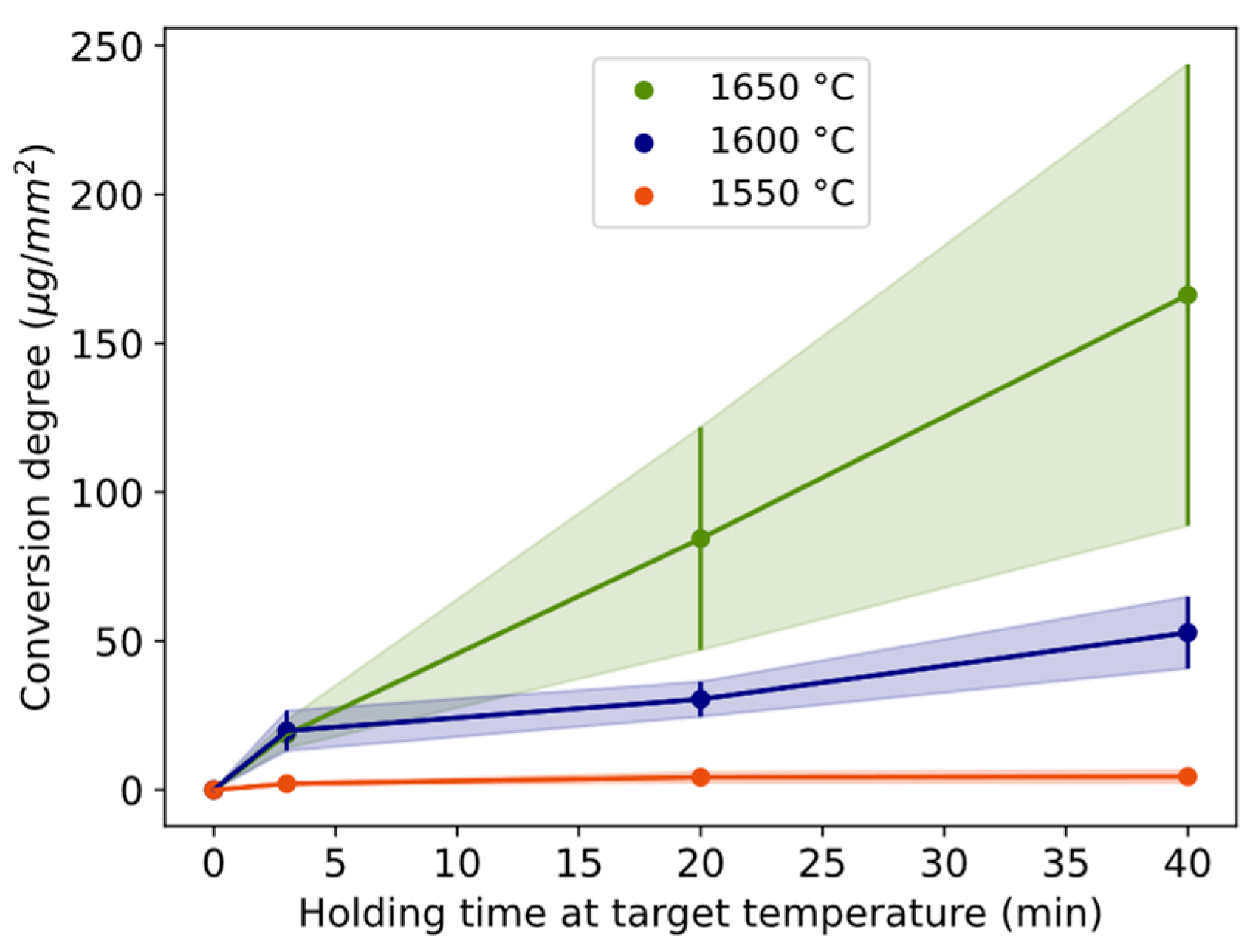
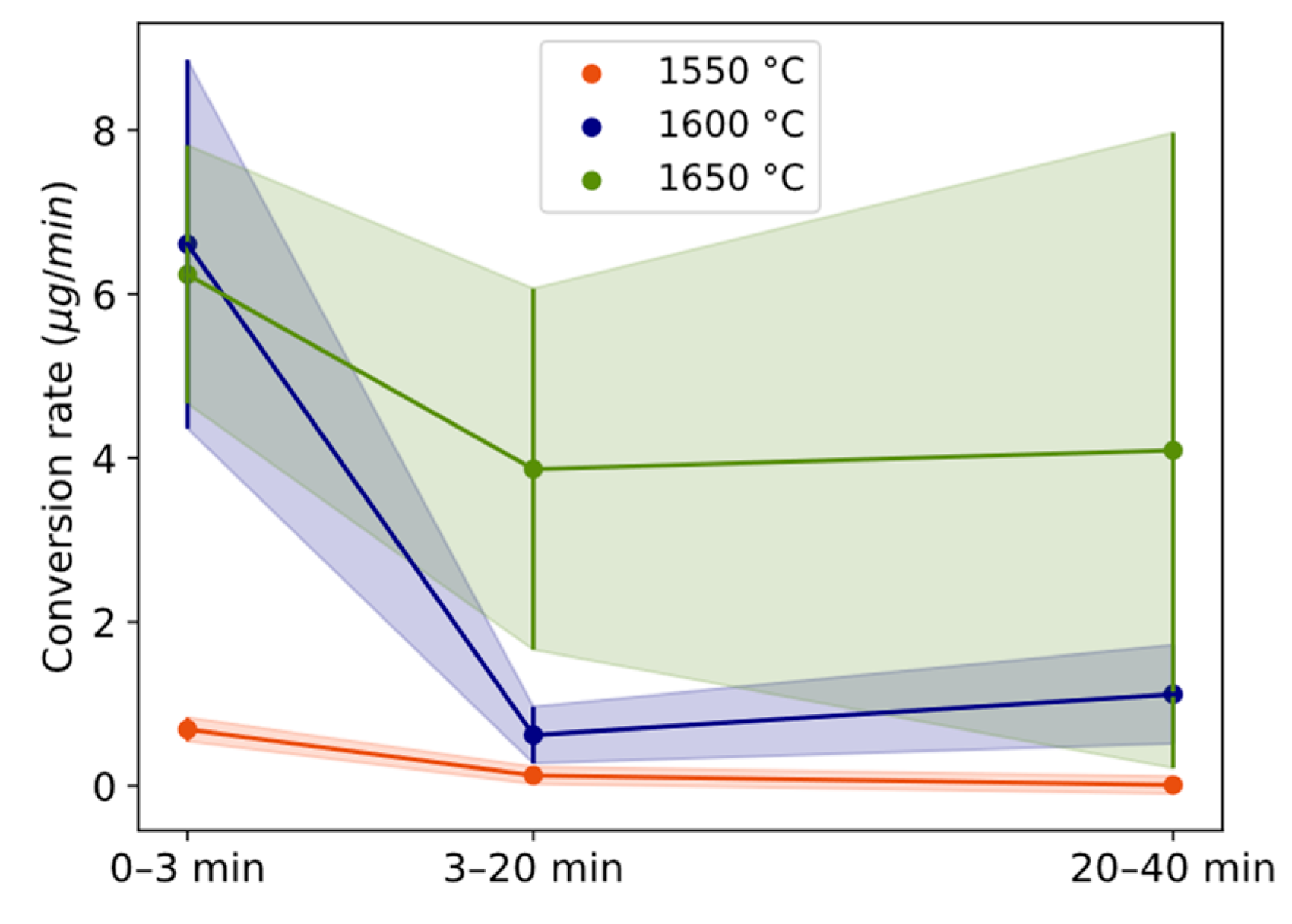
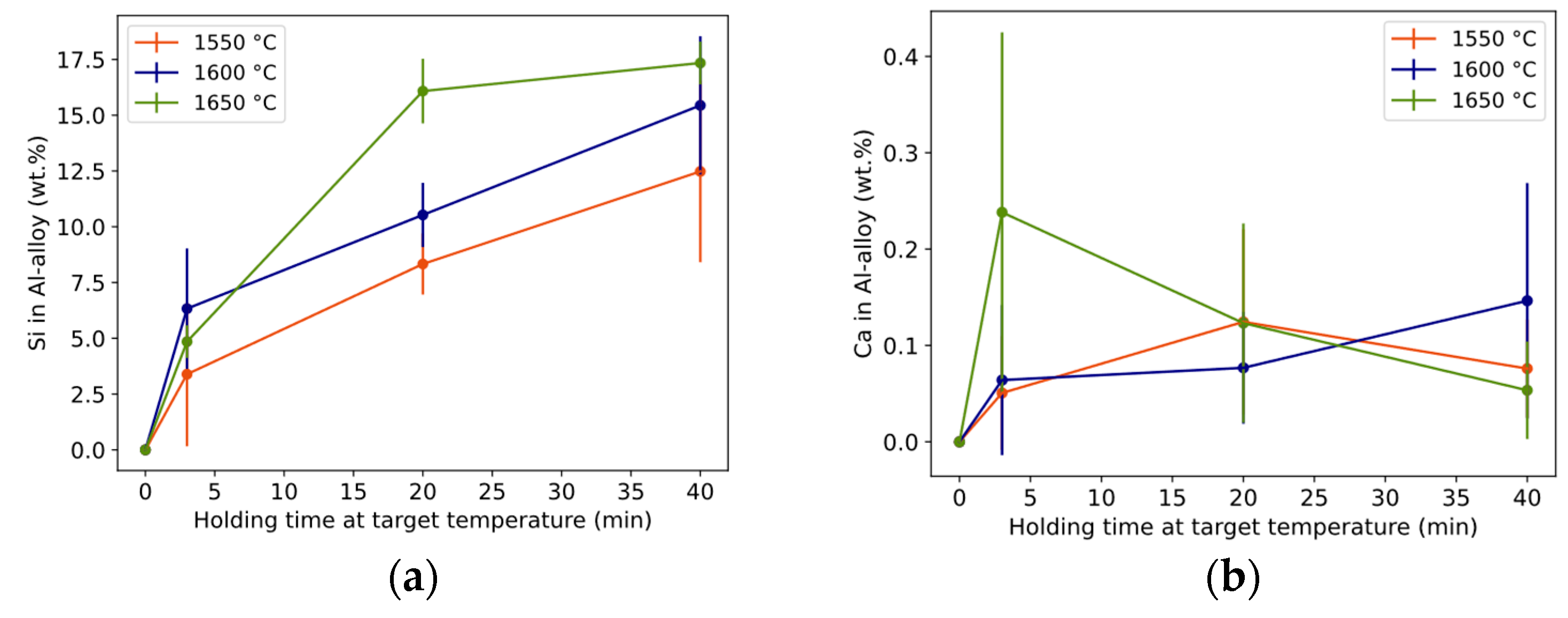

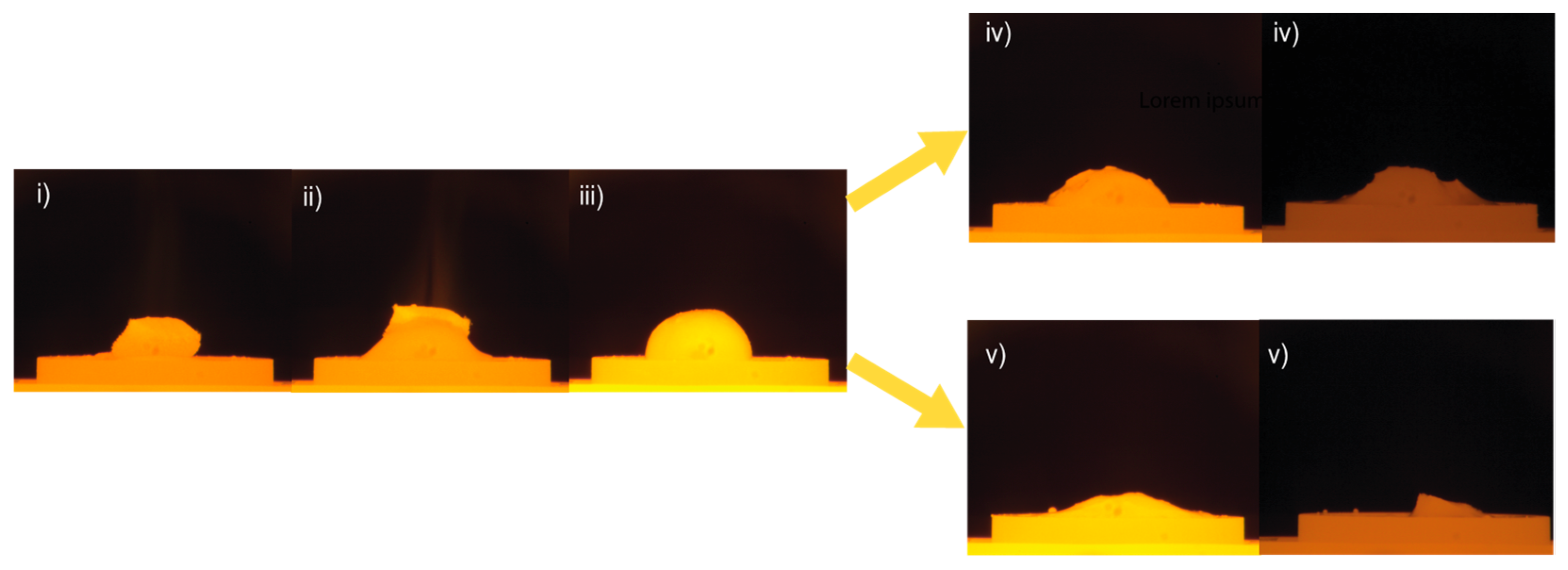
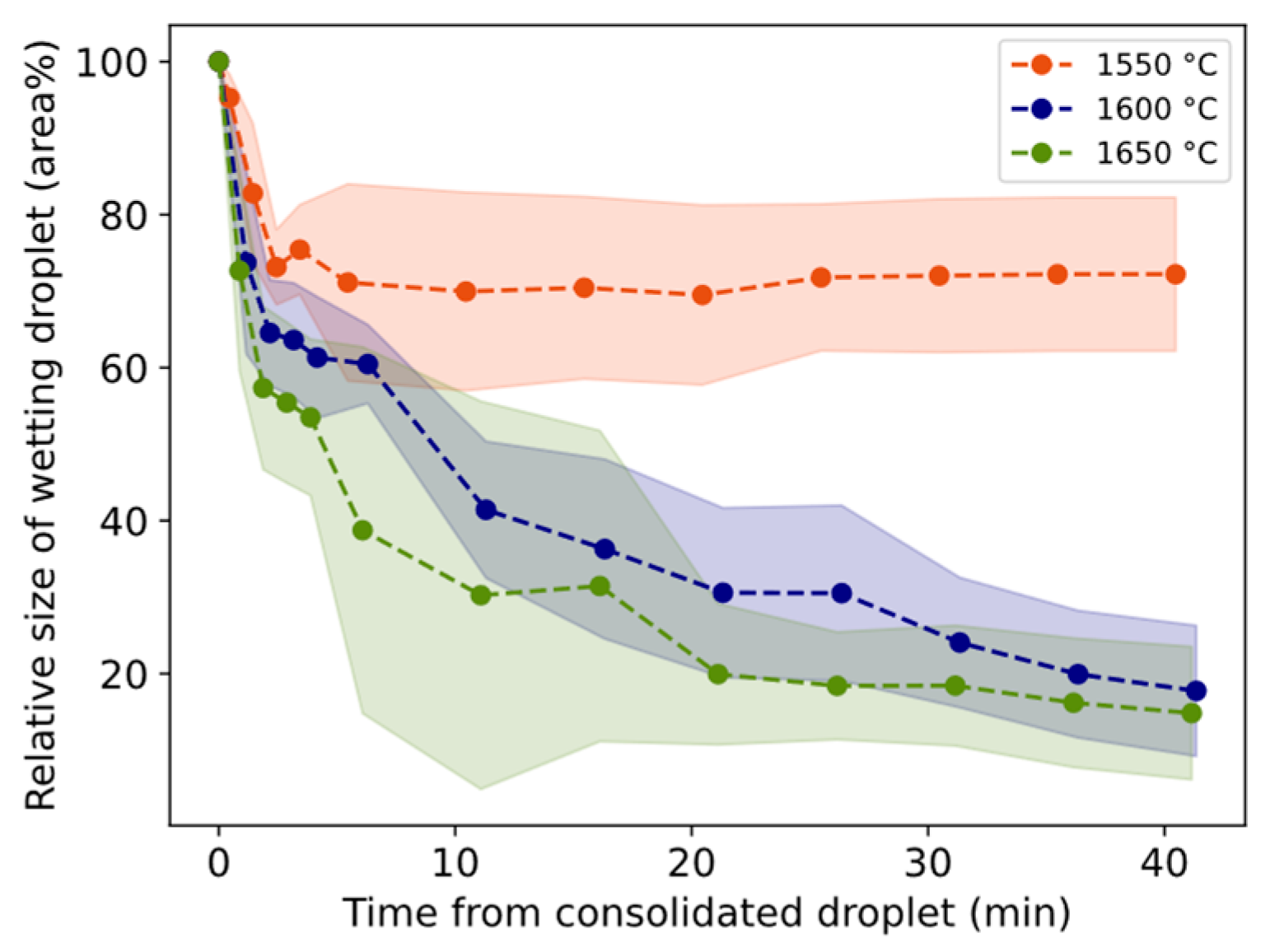
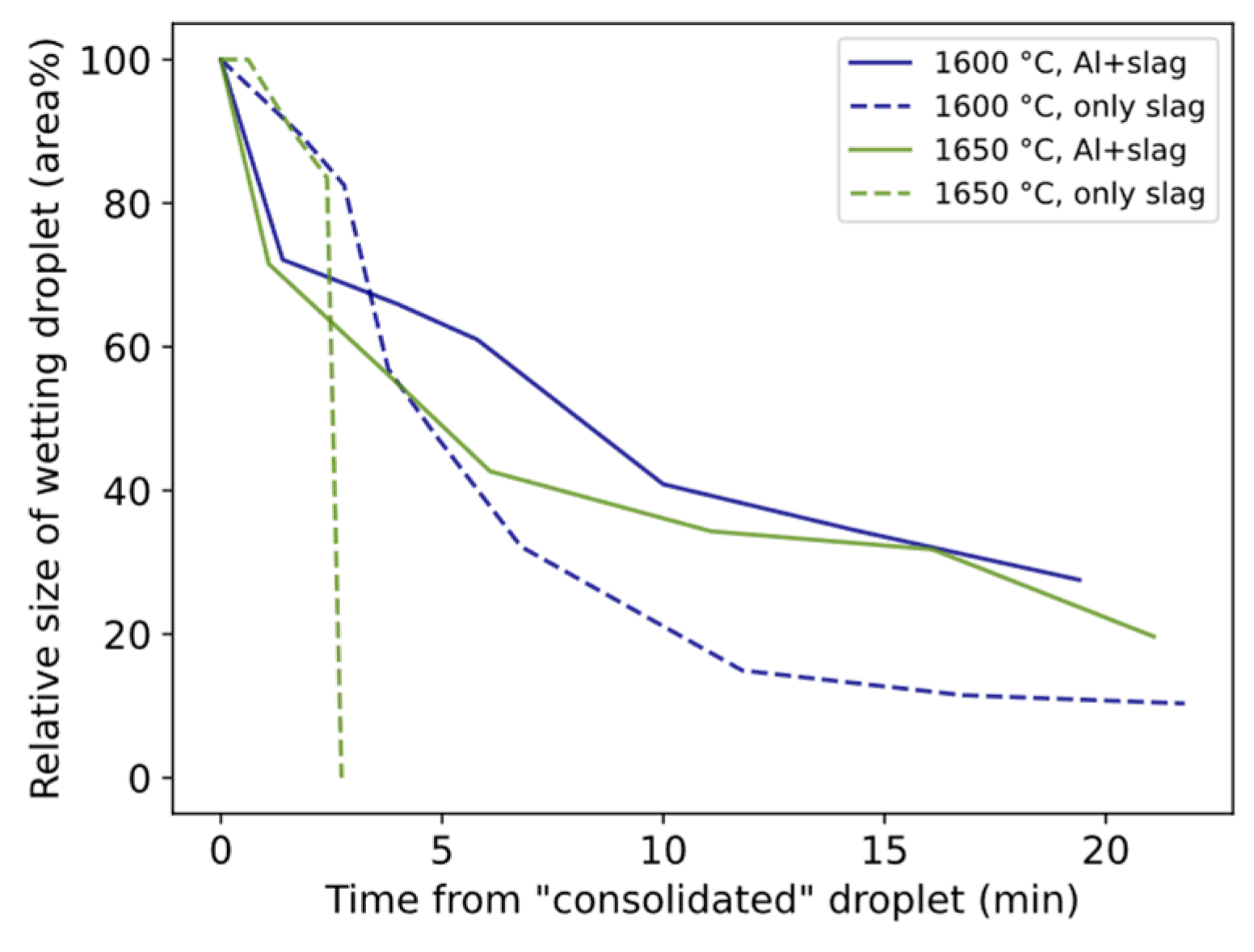

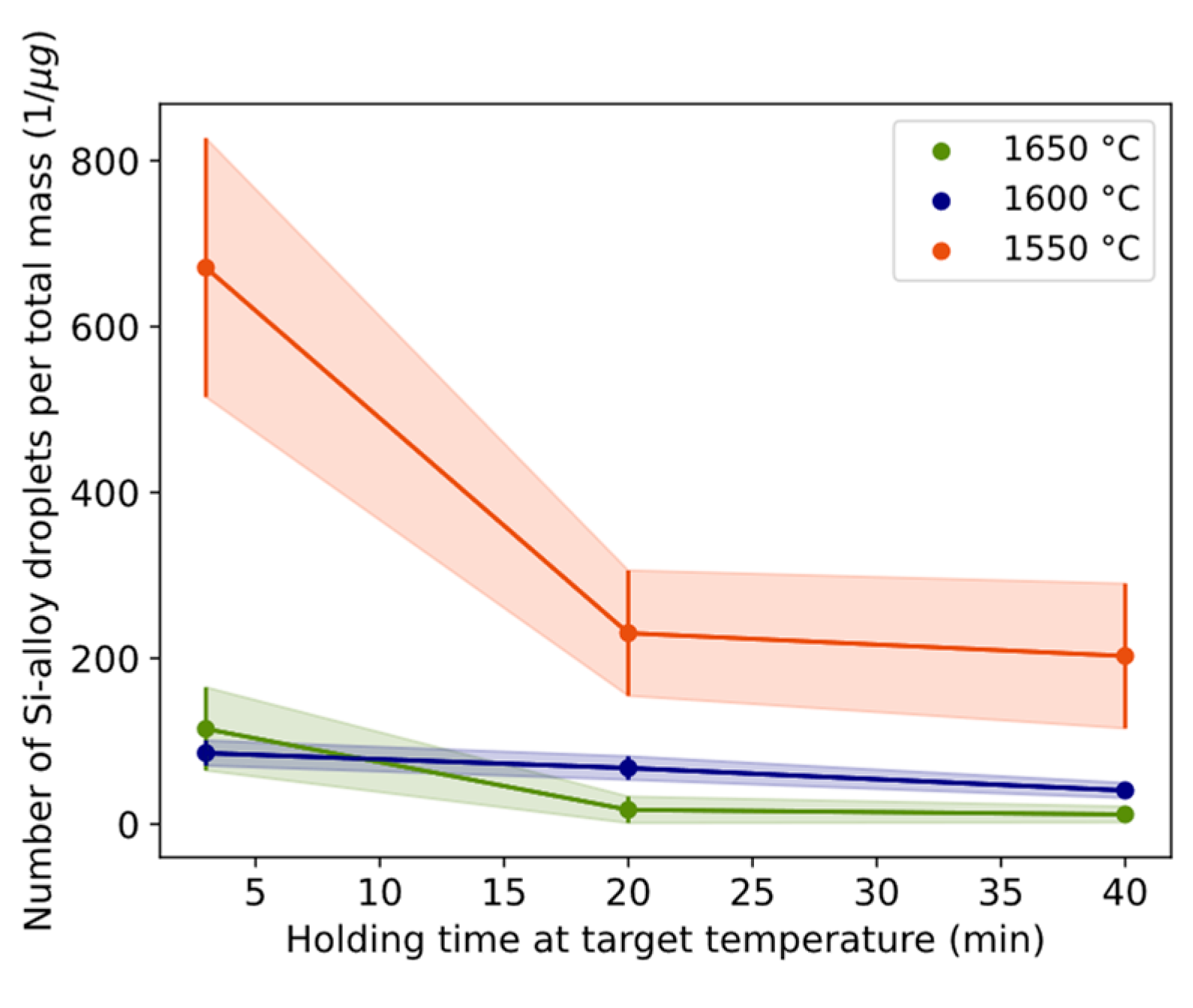
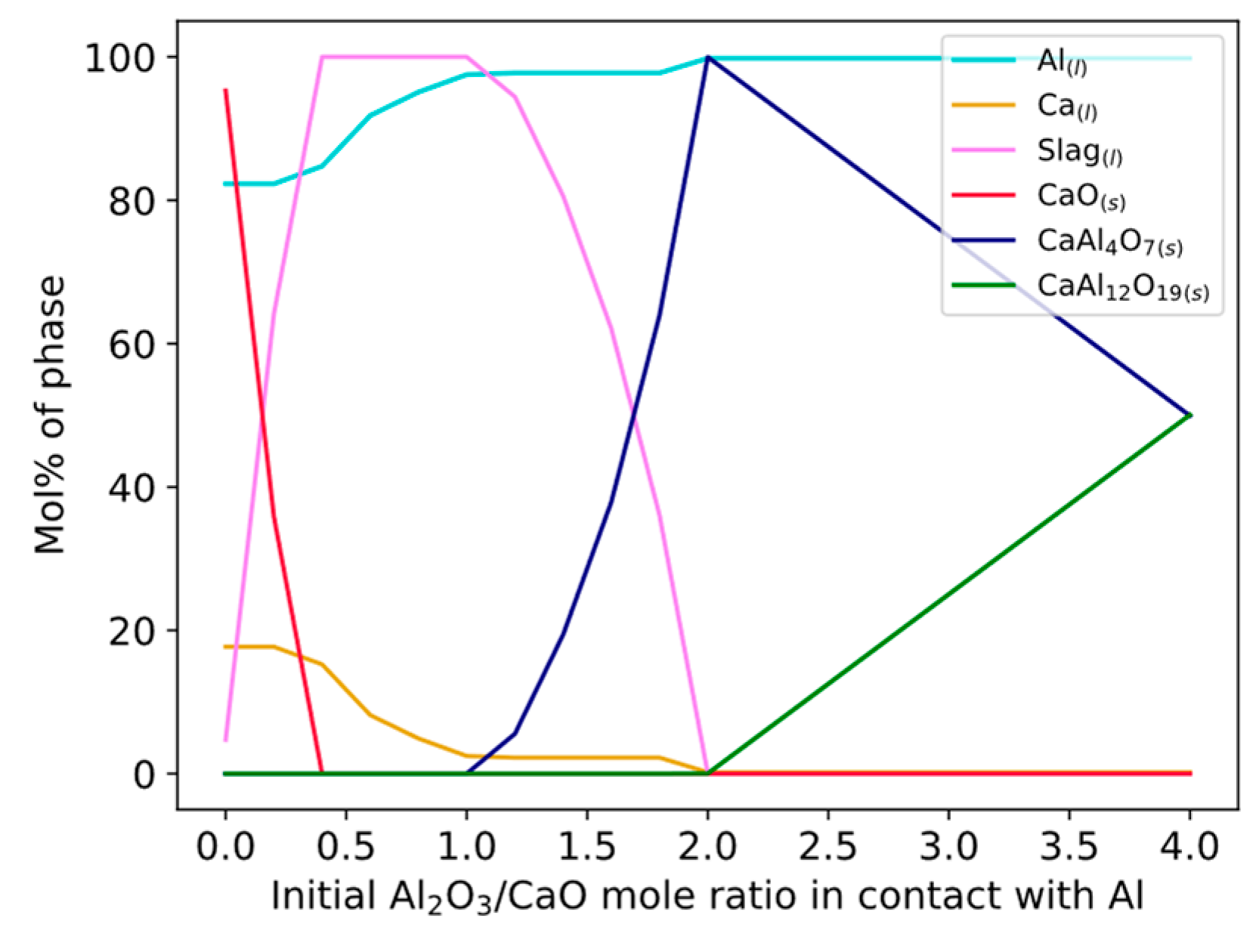
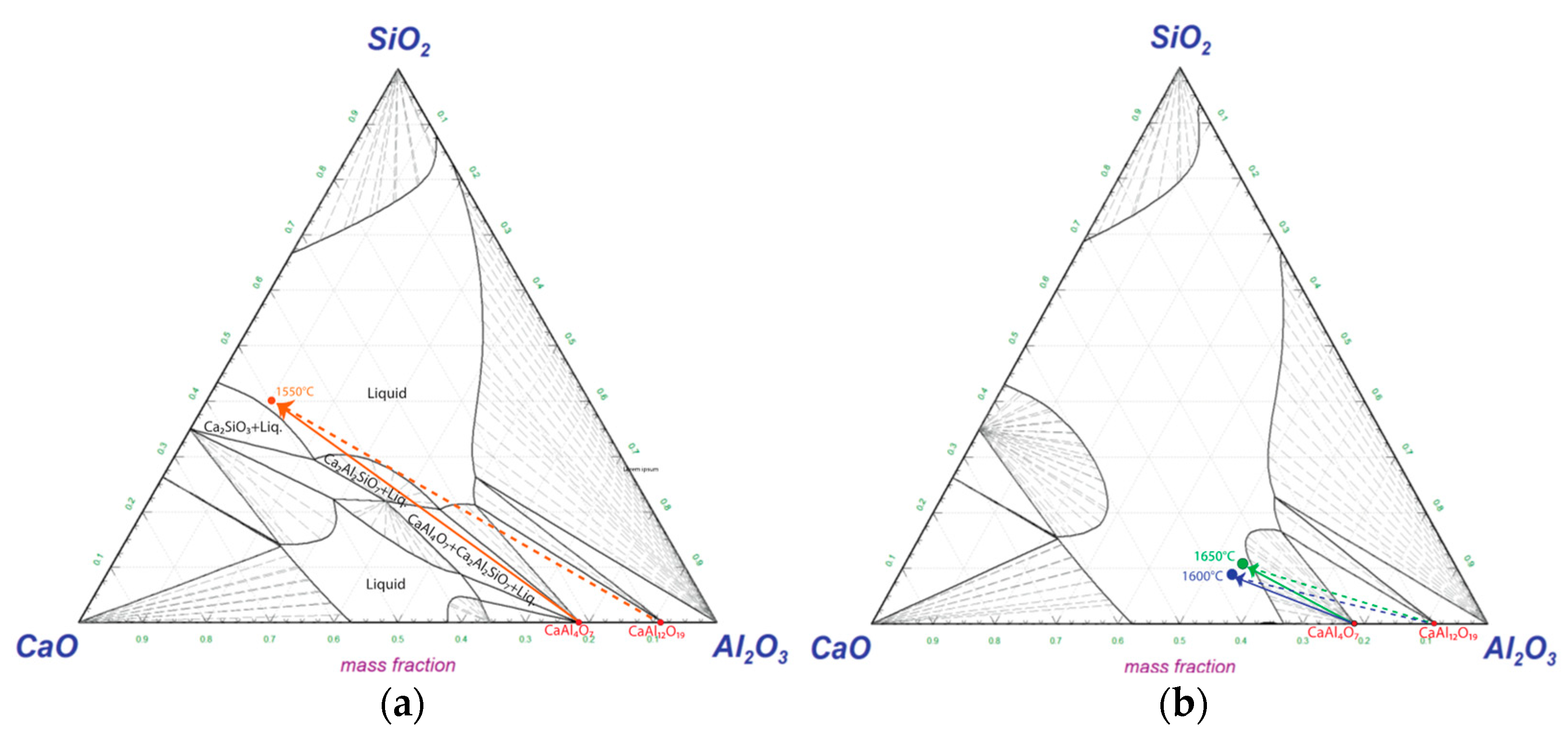
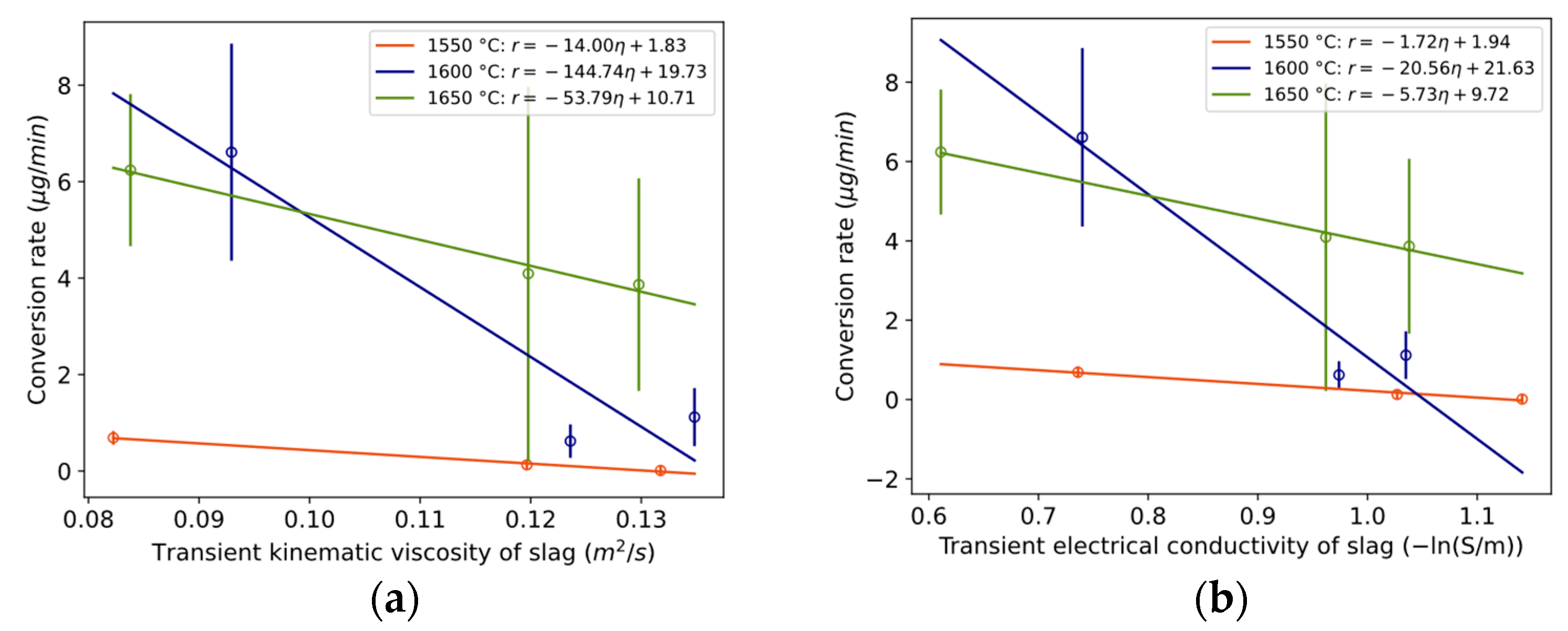
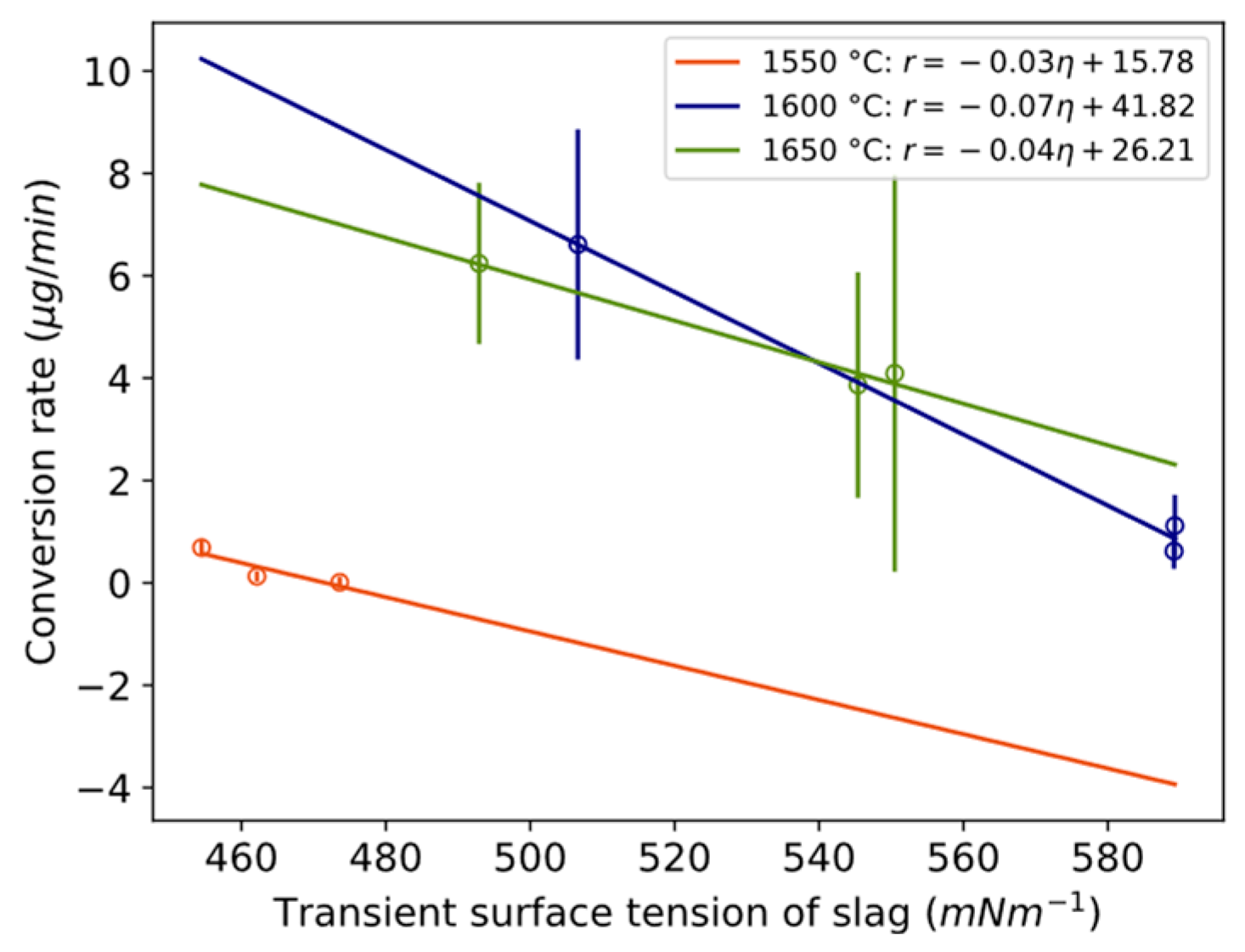

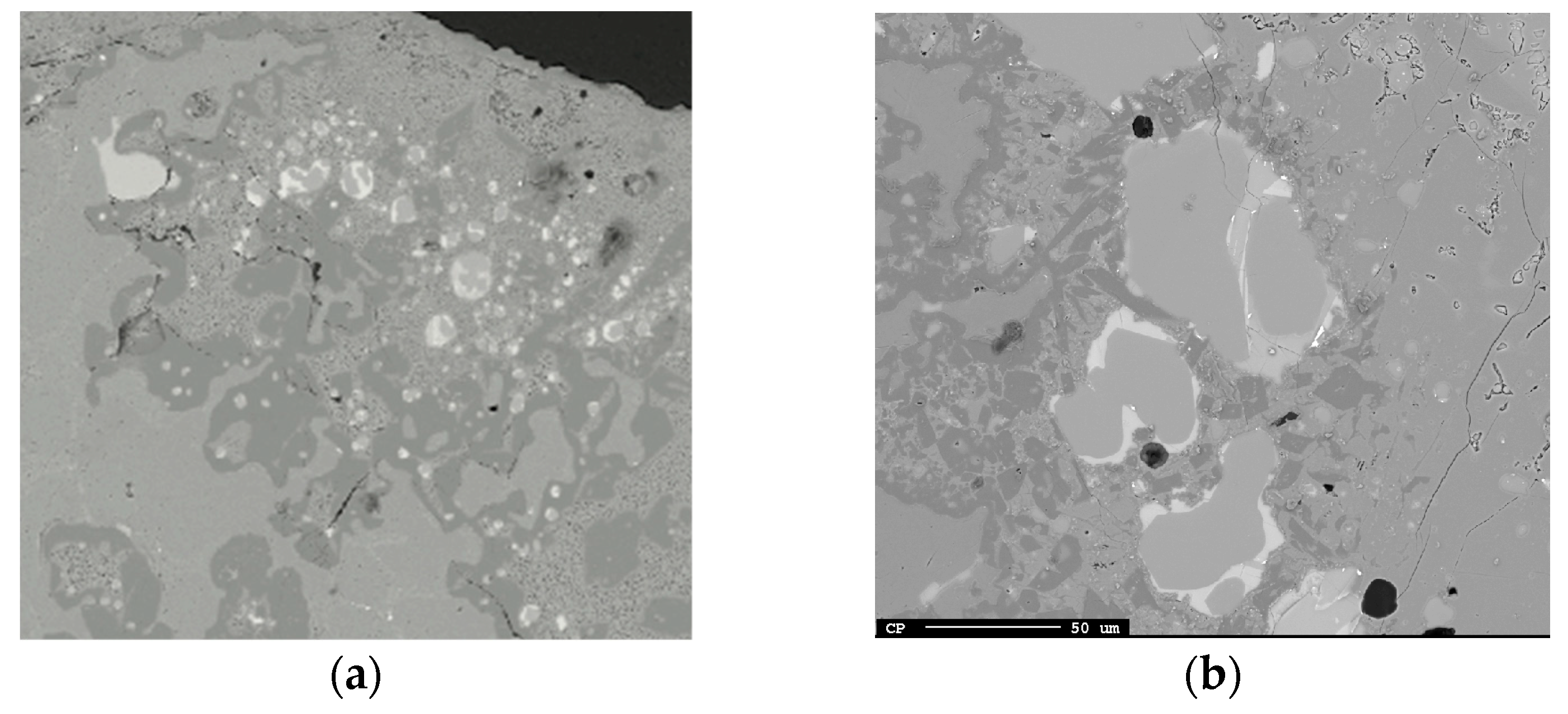
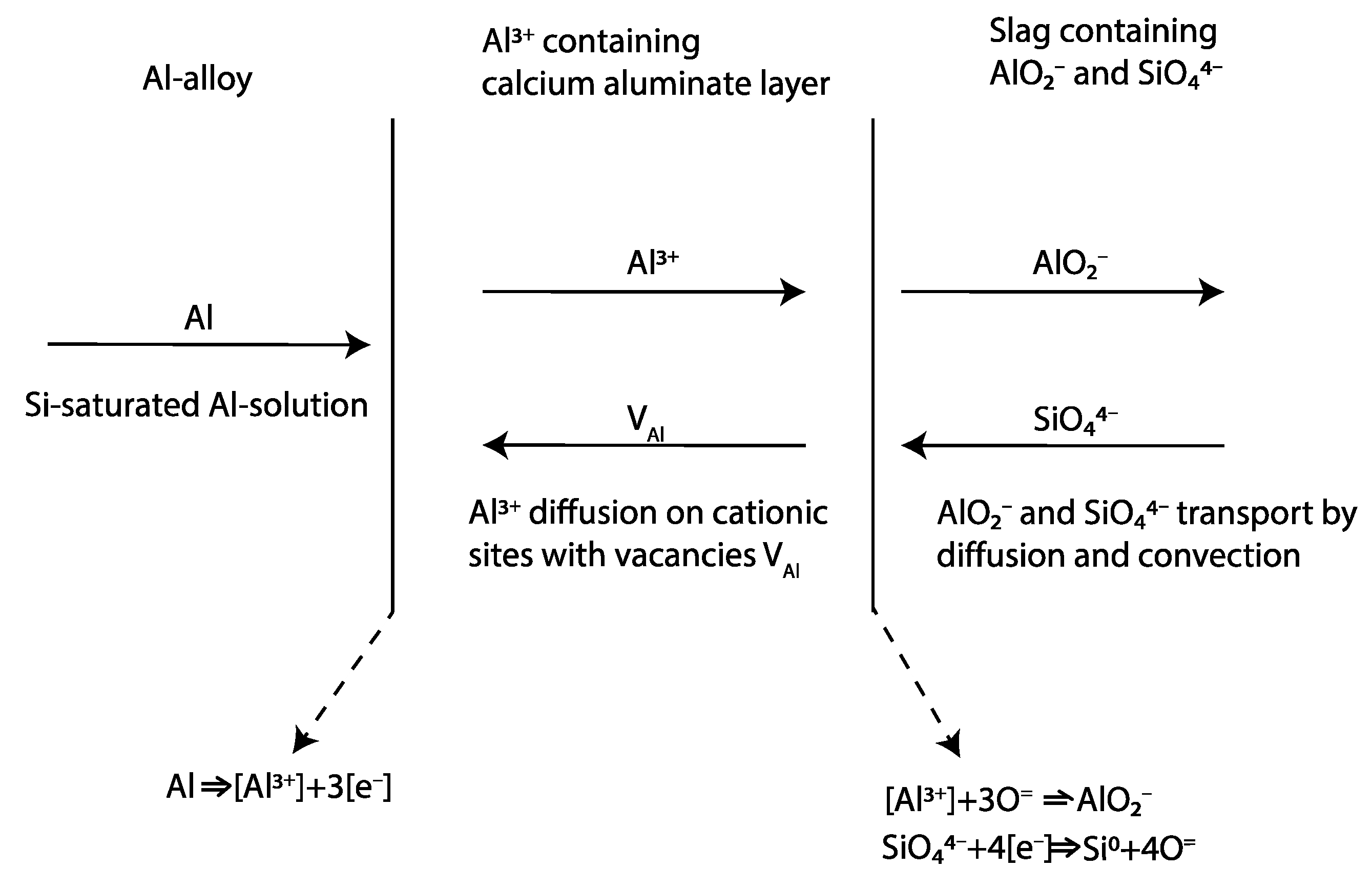
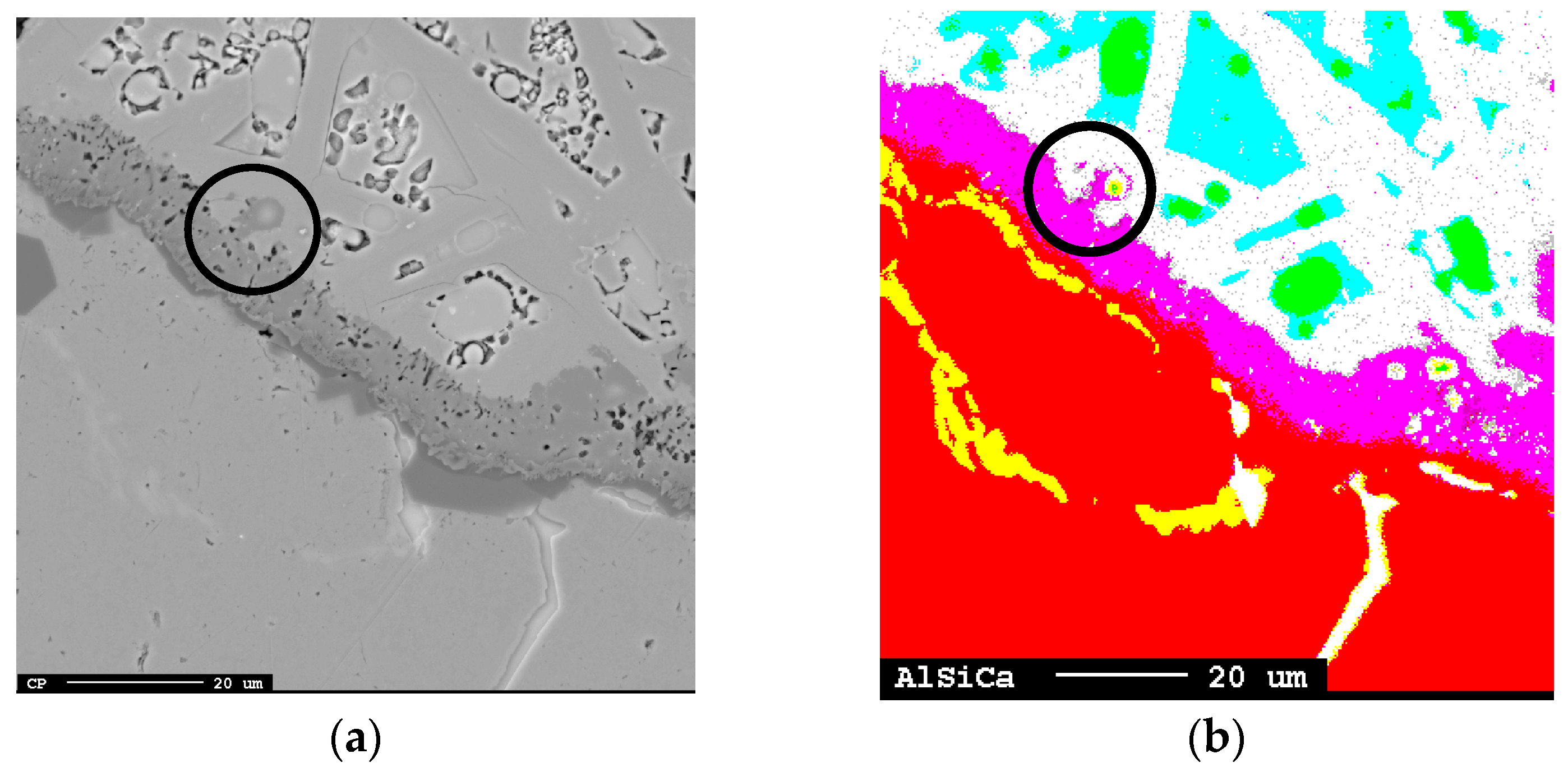

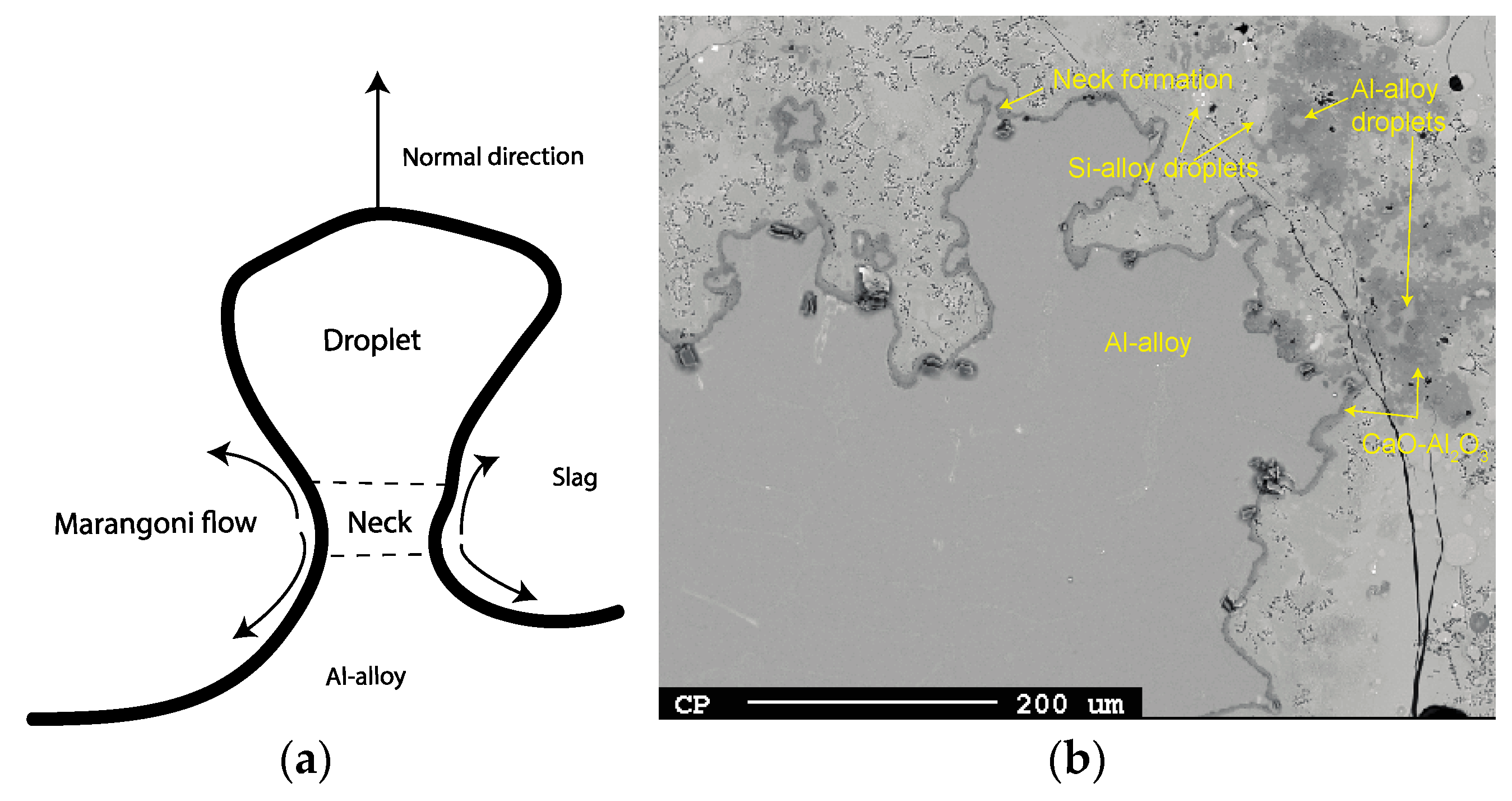
| SiO2 | CaO | Al2O3 | Fe2O3 | MgO | S |
|---|---|---|---|---|---|
| 48.1 | 51.3 | 0.15 | 0.1 | 0.3 | 0.008 |
| 3 min | 20 min | 40 min | |
|---|---|---|---|
| 1550 °C | 2.1 ± 0.4 | 4.2 ± 1.8 | 4.5 ± 2.2 |
| 1600 °C | 19.8 ± 6.7 | 30.5 ± 5.9 | 52.8 ± 12.0 |
| 1650 °C | 18.7 ± 4.7 | 84.4 ± 37.5 | 166.2 ± 77.6 |
| Temp. (°C) | Time (min) | Meas. Al-Alloy | Equil. CaAl4O7 | Equil. CaAl12O19 | Equil. Al-Alloy | ||||
|---|---|---|---|---|---|---|---|---|---|
| Al | Ca | Si | Al | Si | Ca | ||||
| 1550 | 3 | 95.5 | 3.4 | 0.05 | 97.3 | 2.7 | 96.2 | 3.4 | 0.33 |
| 1550 | 20 | 90.7 | 8.3 | 0.12 | 97.0 | 3.0 | 91.2 | 8.4 | 0.43 |
| 1550 | 40 | 86.2 | 12.5 | 0.08 | 95.5 | 4.5 | 86.9 | 12.6 | 0.54 |
| 1600 | 3 | 92.6 | 6.3 | 0.06 | 96.7 | 3.3 | 93.2 | 6.4 | 0.40 |
| 1600 | 20 | 88.2 | 10.5 | 0.08 | 95.9 | 4.1 | 88.9 | 10.6 | 0.50 |
| 1600 | 40 | 83.2 | 15.4 | 0.15 | 95.2 | 4.8 | 83.8 | 15.6 | 0.65 |
| 1650 | 3 | 93.6 | 4.8 | 0.24 | 98.6 | 1.4 | 94.7 | 4.9 | 0.39 |
| 1650 | 20 | 82.5 | 16.1 | 0.12 | 94.6 | 5.4 | 83.1 | 16.2 | 0.68 |
| 1650 | 40 | 81.6 | 17.3 | 0.05 | 93.5 | 6.5 | 81.8 | 17.5 | 0.73 |
| Al2O3 | 3 min | 20 min | 40 min |
|---|---|---|---|
| 1550 °C | 10.4 ± 12.5 | 16.6 ± 0.1 | 21.4 ± 0.2 |
| 1600 °C | 53.0 ± 0.8 | 58.7 ± 3.4 | 55.7 ± 1.4 |
| 1650 °C | 54.2 ± 1.2 | 50.1 ± 1.1 | 53.9 ± 6.4 |
| CaO | 3 min | 20 min | 40 min |
| 1550 °C | 48.7 ± 6.8 | 41.7 ± 3.2 | 45.02 ± 3.2 |
| 1600 °C | 37.5 ± 2.2 | 36.9 ± 1.5 | 35.0 ± 1.8 |
| 1650 °C | 33.7 ± 0.9 | 32.6 ± 2.2 | 36.3 ± 1.8 |
| SiO2 | 3 min | 20 min | 40 min |
| 1550 °C | 40.4 ± 6.0 | 41.2 ± 3.3 | 33.1 ± 3.4 |
| 1600 °C | 8.8 ± 3.0 | 3.8 ± 2.2 | 8.8 ± 3.1 |
| 1650 °C | 11.5 ± 2.0 | 16.8 ± 3.4 | 9.3 ± 8.2 |
| Al2O3 | 3 min | 20 min | 40 min |
|---|---|---|---|
| 1550 °C | 9.6 | 5.9 | 0.1 |
| 1600 °C | n.a. | 1.5 | 5.1 |
| 1650 °C | 2.7 | 11.1 | 5.9 |
| CaO | 3 min | 20 min | 40 min |
| 1550 °C | −6.3 | −4.6 | −2.2 |
| 1600 °C | n.a. | −0.6 | 2.0 |
| 1650 °C | 2.6 | 4.3 | 2.6 |
| SiO2 | 3 min | 20 min | 40 min |
| 1550 °C | −3.3 | −1.3 | 2.0 |
| 1600 °C | n.a. | −1.2 | −7.2 |
| 1650 °C | −5.5 | −15.4 | −8.3 |
| Si Alloy (wt.%) | Product Slag (wt.%) | |||||
|---|---|---|---|---|---|---|
| Si | Al | Ca | SiO2 | Al2O3 | CaO | |
| 1550 °C | 72.8 ± 0.02 | 4.77 ± 0.01 | 22.0 ± 0.01 | 7.3 ± 0.05 | 50.0 ± 0.06 | 42.4 ± 0.02 |
| 1600 °C | 72.1 ± 0.02 | 5.4 ± 0.01 | 22.1 ± 0.01 | 7.6 ± 0.04 | 49.7 ± 0.06 | 42.4 ± 0.02 |
| 1650 °C | 71.4 ± 0.02 | 6.0 ± 0.01 | 22.2 ± 0.01 | 8.0 ± 0.04 | 49.4 ± 0.06 | 42.4 ± 0.02 |
| 0–3 min | 3–20 min | 20–40 min | |
|---|---|---|---|
| 1550 °C | +223.7 | −25.9 | −1.4 |
| 1600 °C | +28.6 | −1.1 | −1.4 |
| 1650 °C | +38.3 | −5.7 | −0.3 |
| 0–3 min | 3–20 min | 20–40 min | |
|---|---|---|---|
| 1550 °C | 10.3 | 1.03 | 1.56 |
| 1600 °C | 15.4 | 0.73 | 1.65 |
| 1650 °C | 10.6 | 3.59 | 0.13 |
Disclaimer/Publisher’s Note: The statements, opinions and data contained in all publications are solely those of the individual author(s) and contributor(s) and not of MDPI and/or the editor(s). MDPI and/or the editor(s) disclaim responsibility for any injury to people or property resulting from any ideas, methods, instructions or products referred to in the content. |
© 2024 by the authors. Licensee MDPI, Basel, Switzerland. This article is an open access article distributed under the terms and conditions of the Creative Commons Attribution (CC BY) license (https://creativecommons.org/licenses/by/4.0/).
Share and Cite
Philipson, H.G.R.; Wallin, M.; Einarsrud, K.E. Investigation of Liquid–Liquid Reaction Phenomena of Aluminum in Calcium Silicate Slag. Materials 2024, 17, 1466. https://doi.org/10.3390/ma17071466
Philipson HGR, Wallin M, Einarsrud KE. Investigation of Liquid–Liquid Reaction Phenomena of Aluminum in Calcium Silicate Slag. Materials. 2024; 17(7):1466. https://doi.org/10.3390/ma17071466
Chicago/Turabian StylePhilipson, Harald G. R., Maria Wallin, and Kristian Etienne Einarsrud. 2024. "Investigation of Liquid–Liquid Reaction Phenomena of Aluminum in Calcium Silicate Slag" Materials 17, no. 7: 1466. https://doi.org/10.3390/ma17071466
APA StylePhilipson, H. G. R., Wallin, M., & Einarsrud, K. E. (2024). Investigation of Liquid–Liquid Reaction Phenomena of Aluminum in Calcium Silicate Slag. Materials, 17(7), 1466. https://doi.org/10.3390/ma17071466









